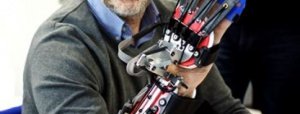At the chronic stages of stroke, patients are not likely to be receiving treatment but they continue to live with some impairments — the glove’s goal is to provide therapies to target these impairments.
Tailoring treatment
Over the past three years the team developed two prototype robotic gloves, which facilitate repetitive movement and exercise of the hand and wrist. The device also records the patient’s performance and sends this to a therapist for tailoring treatment remotely and arranging
Dr Farshid Amirabdollahian, an expert in rehabilitation robotics and assistive technologies and a senior lecturer in adaptive systems at the University’s School of Computer Science
Clinical improvements
Dr Amirabdollahian said: «This project focused on therapies for stroke patients at home. Our goal was to make motivating therapies available to people to practise at home using this system, hoping that they have a vested interest to practise and will do so. We tried this system with 30 patients and found that patients indeed practised at home, on average around 100 minutes each week, and some showed clinical improvements in their hand and arm function».
Positive therapy sessions
The overall aim of the project was to provide an educational, motivational and engaging interaction, making a more positive therapy session for the patient, while providing feedback to them and their health care professionals. Given the results achieved, the team is now considering a
The team have passed the
Other project partners are:
Acknowledgement
This project was partially funded by the European Commission under the 7th Framework Programme.
http://www.herts.ac.uk

